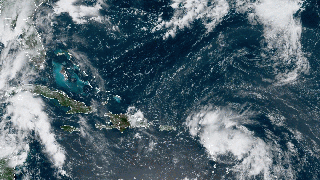
Tropical Storm Marco formed Friday in the northwestern Caribbean, joining Tropical Storm Laura as what could become a double threat within days to a huge stretch of the U.S. Gulf Coast.
The U.S. National Hurricane Center said Marco has emerged about 180 miles (290 kilometers) southeast of Cozumel, Mexico. The storm’s maximum sustained winds were near 40 mph (65 kph) and it was expected to move near the Yucatan Peninsula on Saturday. The storm is headed north-northwest at 13 mph (20 kph).
Marco became a tropical storm on the heels of Laura, which set a record for the earliest 12th named storm of a season when it formed on Friday morning northeast of the Lesser Antilles.
Forecasters said the center of Marco will cross the northeastern part of Mexico’s Yucatan Peninsula on Saturday night and move over the central Gulf of Mexico toward the northwestern Gulf on Sunday and Monday. Additional strengthening is expected and forecasters say Marco could be near hurricane strength when it moves over the central Gulf in coming days.
Get top local stories in San Diego delivered to you every morning. >Sign up for NBC San Diego's News Headlines newsletter.
If both storms survive the weekend, Laura is forecast to head toward the central Gulf Coast around Louisiana, Mississippi, Alabama and the western Florida Panhandle, while the other system aims at Texas. The National Hurricane Center's late Friday afternoon forecast pushed both farther west and slowed Laura's track.
“A lot of people are going to be impacted by rainfall and storm surge in the Gulf of Mexico,” said Joel Cline, the tropical program coordinator for the National Weather Service. “Since you simply don’t know you really need to make precautions.”
Two hurricanes have never appeared in the Gulf of Mexico at the same time, according to records going back to at least 1900, said Colorado State University hurricane researcher Phil Klotzbach. The last time two tropical storms were in the Gulf together was in 1959, he said.
U.S. & World
Because the hurricane center slowed Laura's entrance into the Gulf and moved its track westward, the two storms are now forecast to be together in the Gulf on Tuesday, just before the weaker western storm smacks Texas with Laura making landfall a bit less than a day later.
The hurricane center on Friday issued tropical storm warnings for the northern Leeward Islands and Puerto Rico. Laura was forecast to smack Puerto Rico on Saturday morning, go over or near the Dominican Republic and Haiti late Saturday and Cuba on Sunday.
Laura, which set a record for the earliest 12th named storm of a season, was moving through the northern Leeward Islands on Friday evening, about 250 miles (415 kilometers) east-southeast of San Juan, Puerto Rico. It had maximum sustained winds of 45 mph (75 kph) and was heading west at 17 mph (28 kph).
The hurricane center also issued a tropical storm warning and hurricane watch for part of Mexico's Yucatan Peninsula because the other storm system, called Tropical Depression 14, was predicted to strengthen into a tropical storm by Saturday.
On Friday evening, it was centered about 210 miles (340 kilometers) southeast of Cozumel, Mexico, with 35 mph (55 kph) winds. It was headed northwest at 13 mph (20 kph).
If the two storms make it, they could be crowded in the Gulf of Mexico at the same time Tuesday about 550 miles apart. That would leave open some weird possibilities, including the storms rotating around each other in a tropical two-step, pulling in closer to each other, nudging each other, weakening each other or — far less likely — merging.
The last time two storms made landfall in the United States within 24 hours of each other was in 1933, Klotzbach said.
It seems fitting for 2020 to have this type of twin threats, said University of Miami hurricane researcher Brian McNoldy.
“Of course, we have to have two simultaneously land-falling hurricanes,” McNoldy said. “It’s best not to ask what’s next.”
On Friday morning, a hurricane-hunting airplane found Laura's center to be dozens of miles farther south and better formed than satellite images showed. That triggered a shift in the forecast track, putting Caribbean islands more at risk and an upgrade to tropical storm status.
If Laura goes over land, Puerto Rico and the mountains of Haiti, the Dominican Republic and Cuba could tear it apart and not make it much of a threat to the mainland United States, meteorologists said. But if it misses or skirts land, it could head into warm waters conducive to strengthening as it approaches Florida, meteorologists said.
With competing scenarios, the hurricane center is forecasting a middle range for Laura of a weak hurricane heading into the eastern Gulf of Mexico.
Officials in the Florida Keys, which Laura might pass over on its route into the Gulf, declared a local state of emergency Friday and issued a mandatory evacuation order for anyone living on boats, in mobile homes and in campers. Tourists staying in hotels should be aware of hazardous weather conditions and consider altering their plans starting on Sunday, Monroe County officials said in a news release.
Citing both storm systems, Louisiana Gov. John Bel Edwards declared a state of emergency Friday night. “It is too soon to know exactly where, when or how these dual storms will affect Louisiana, but now is the time for our people to prepare for these storms,” Edwards said in a statement.
Meteorologists said Tropical Depression 14 has a better chance of surviving its early land encounter, then strengthening to a minimal hurricane over warm water, but the hurricane center was forecasting it to weaken before it reaches the U.S. Gulf Coast because of decapitating high winds.
___
Associated Press reporter Freida Frisaro in Miami contributed to this report.



